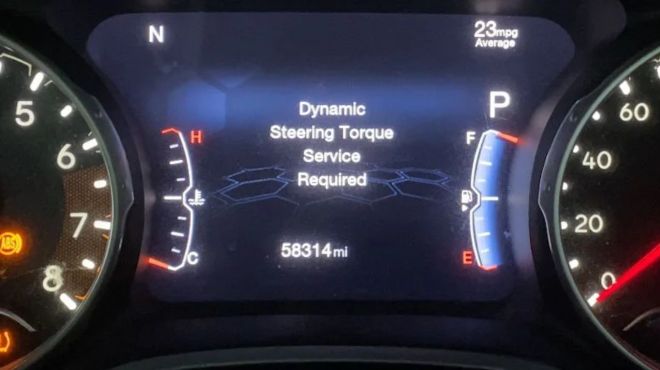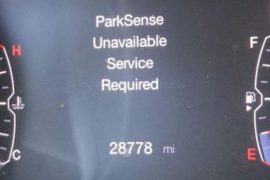A frequent culprit behind the “Dynamic Steering Torque Service Required” warning in Jeep Renegade and Compass vehicles stems from interconnected system faults. Sensors feeding incorrect data, malfunctioning ABS modules, low voltage conditions, and software issues commonly trigger the fault indicator, often alongside related alerts for power steering, parking brakes or stability control.
Quickly scanning codes and inspecting components like batteries and ABS sensors is key to restoring proper torque control and avoiding complete disablement of steering or drivetrain functions when this alert appears unexpectedly.

As mentioned above, the reasons behind the warning light could range from a low battery to faulty sensors to outdated software. We’ll explore some of the common culprits together. And I’ll provide a roadmap of troubleshooting tips to get your ride’s steering back on track.
What Causes the Dynamic Steering Torque Warning?
Essentially, Dynamic Steering Torque (DST) is a helpful feature that senses when your vehicle’s ability to stay steady around corners or in slippery conditions might be compromised. It can automatically adjust steering wheel resistance and braking power to avoid fishtailing or loss of control. But if something goes awry with that system, you get that foreboding service notice.
Faulty battery or alternator
So your dynamic steering assist suddenly vanished, replaced by that unnerving service message. Like a trip down a winding cliffside road, navigating the cause can be harrowing. Let’s first check the two most likely culprits: an ailing battery or alternator problem.
Think of your car’s electrical system like a river supplying water wheels, candles, and rainbow makers (that’s the fancy stuff under your hood). If voltage levels start dropping, those dash lights won’t shine as brightly. More importantly, your electric steering and stability systems strain for precious power, cutting off to protect essential operations. Just like a dried-up riverbed. Identifying bad battery cells or drives of alternators not recharging properly stops this flow famine.
Issues with ABS system
Issues in your car’s interconnected ecosystems can also disrupt steering torque function. The Anti-Lock Braking System has an intricate network of wheel speed sensors and control modules working in harmony to detect slippage and govern torque for steady handling. If previous repair shops left sensors askew or mismatched software between modules during updates, that delicate balance is thrown off.
It’s like an orchestra falling out of tune, with the steering torque light the blaring tuba signalling all is not well. Proper diagnoses to resolve disagreements between ABS components will get you cruising confidently again.
Bad wheel or angle sensor
Like a detective questioning shady characters, we have to examine other usual suspects that could be feeding bad intel to your car’s brain and causing steering torque turmoil.
Wheel speed and angle sensors are responsible for collecting road data and sending it to the control modules to adjust torque and stability. But if their information gets scrambled like a faulty GPS, your car’s decisions will be misguided. This confusion can occur due to manhandled sensors during tire changes or accumulated dirt and debris providing nonsense inputs.
Outdated software
Software as outdated as a flip phone can also bungle torque calculations. Failing to install control module updates from your manufacturer leaves your car’s computational power in the dark ages. Like expecting Siri-level voice commands from an analog assistant called Dave. Modernizations in progressing machine learning and detecting slippery conditions necessitate consistently updating the electronic brain.
Water ingress
Finally, moisture seeping into plugs and wirings can short-circuit communication between torque sensors and processors. Think Upload glitching because of bad Ethernet cables. Carefully inspecting grommets, seals, and casing for leaks or corrosion can prevent further moisture damage.
We’ve questioned the shadiest lineup of torque-tampering suspects. Now let’s discuss how to interrogate them to get your torque back on track!
Also see – ParkSense Unavailable Service Required: Causes and Fixes
How to Diagnose and Fix?
Alright, time to get elbow-deep under the hood to diagnose and get your dynamic steering back on track. Let me walk you through some key troubleshooting steps.
Check battery and alternator first
First, whip out the voltmeter and check battery and alternator health. Low voltage can mimic signals of bad torque sensors to modules when none exist. Replacing drained batteries or worn-down alternators restores full electrical flow.
Make sure connections are secure as well in case corrosion or shakes on bumpy roads jostled plugs loose. Clean terminals and firmly reattach any wiggly wiring harness.
Scan for codes to identify faulty module or sensor
Next, bust out an OBD2 scanner tool to check for any diagnostic trouble codes stored for torque system malfunctions. You hopefully see the specific component like a wheel sensor or ABS module controller acting up. Swap out the identified problem part if replacement needed.
Sometimes controllers just need a software reset after scanning, similar to restarting a sluggish laptop. Disconnect the battery for 15 minutes then reboot your ride’s computer. This forces modules to recalibrate and clears up intermittently glitchy electronics. Any stubborn trouble codes confirm the component indeed needs to be replaced.
Inspect wires and connections for water damage
Moisture buildup can cause electrical resistance spikes like torrential downpours flooding roads. Carefully inspect wires, harness connectors, and control module seals for corrosion, leaks or water ingress pathways. Look for green oxidization, pin corrosion, or swollen water-logged casings. Create a barricade with dielectric grease on plugs and replace aged cracked gaskets that compromise sensitive electronics to the elements.
Update software if needed
Out-of-date software can also muck up the torque works. Using an OBD scanner, check what firmware and updates are installed on modules versus the latest manufacturer recommends. Refresh any missing patches so sensors interpret vehicle dynamics accurately. This avoids unpredictable traction adjustments from running partially-updated code.
Replace damaged parts
Finally, if all troubleshooting avenues lead to the same glitchy component, replace damaged parts to restore faithfully executing dynamic torque duty. Whether an inoperable sensor or glitchy ABS module with fitful communications, swap in working factory parts to get systems collaborating smoothly again.
With these closing steps, hopefully any lingering torque gremlins are vanquished for good. Now let’s drive towards the finish line and recap what we covered on this troubleshooting journey together!
The Perks of Addressing That Torque Warning Promptly
Making the time to properly diagnose and repair warning signs preserves business as usual steering operations plus reactivates extra driving safeguards. Staying on top of dynamic torque service notifications keeps your vehicle handling predictably around curves and preventing dangerous fishtails in slick conditions.
The electronic aids to stabilize traction and complement steering response will come back online after clearing faulty trouble codes or replacing glitchy hardware. Leave issues unaddressed and you risk gradual deterioration of control behind the wheel in precarious situations. So take action at the first sight of any dynamic steering alerts on the dashboard.
Conclusion
Hopefully you now feel empowered to decode that “dynamic steering torque service required” alert if it ever darkens your dash display. While the notification may seem ominous, often it just takes a few voltage checks and component swaps by your nearest service technician to get back on the road confidently.
Think of it like a helpful early warning from your car about needing some extra TLC and fine-tuning. Attending quickly to the caution light restores those helpful electronic aids that brake and steer subtly in slippery spots or high speed corners. And taking a proactive approach avoids getting caught off guard down the road by a bigger issue like complete electric steering loss.
While more convenient to ignore that first whisper of torque trouble, I advise listening closely to get your car’s guidance system locked back on course. By following these troubleshooting tips to address the root issue right away, you’ll keep cruising smoothly wherever the road takes you!



